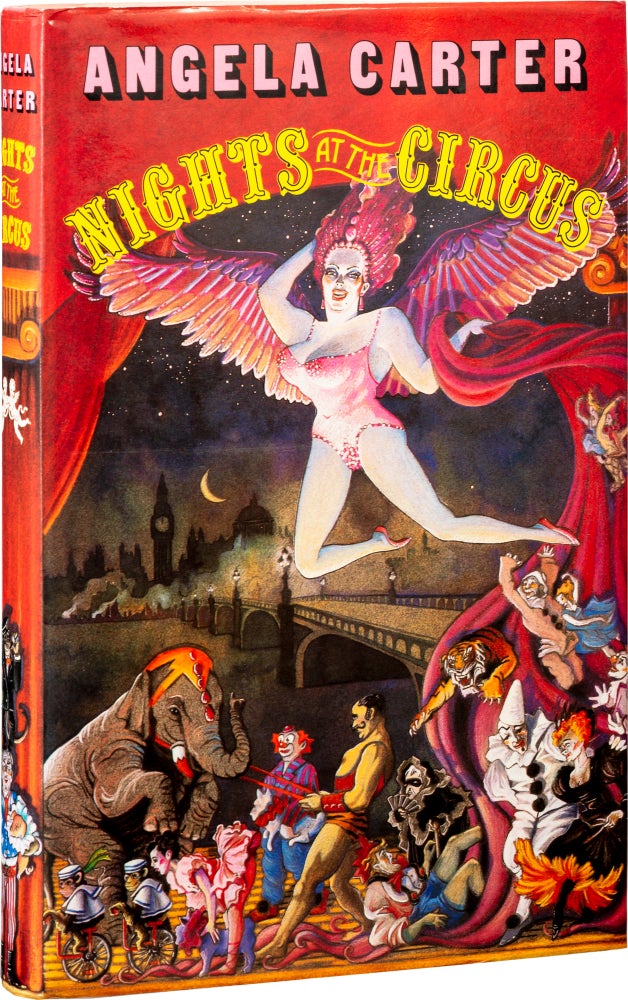
Nights at the Circus
London: Chatto & Windus, The Hogarth Press, 1984. First Edition. Hardcover. 1st edition, preceding the NY edition. Fine in fine dustjacket, with no need to look further if this is a 1st edition you want, just as there is no need to travel around the world, if all you want to do is count the number of cats in Baltimore. fine / fine. Item #438
Get ready to duck because in the perpetual vertigo that is 20th century books, here come the 1980s, a decade with an engine but no engineer, filled with 1st editions that are younger than hope. Right now the decade is just an unfolding of miscalculations because it’s still too early to tell which of the ’80s novels will deserve eager pursuit by, and ready cash from, collectors a generation from now. I’ll try a quick take on this one: Fevvers, a baby, is found on the doorstep of Ma Nelson’s brothel in a basket of eggshells and straw (deliberately recognizable pre–vision). She’s raised as the common daughter of 6 working mothers until, at 14, the constant itching in her shoulders heralds the breaking out of her wings, symbolic of female liberty and volition. She matures some, works herself through a series of persecuted employments where she is exploited as a freak, and develops some of the qualities of a confidence woman, finally landing at the Cirque d’Hiver as the “aerialiste.” She then joins Captain Kearney’s Grand Imperial Tour and becomes the new living legend, applauded by the rich and mighty around the world. She takes up with (but does not fuck) Walser, a journalist who has joined the circus as a clown to be near her. A train wreck, between Russian touring engagements, separates them in Siberia. He is saved by Olga, an escapee from a grotesque women’s prison (a subplot with another of Carter’s subversive takes on feminism), while Fevvers, hampered by a broken wing, is herself saved by a wandering male radical, whose political group is in league with Olga’s activist society. In the end, Fevvers and Walser are reunited, but that’s the only splinter of this novel that approaches normalcy.
Now, take a step back because Nights at the Circus is a door that opens inward. By 1984, Carter was unshackled through her literary success, and secure as feminism’s pre–eminent mythologist, so she cultivated the tenaciousness of an iTunes update. Constrained only by the limits of her inspiration she discarded all organizational method and unleashed a new literary anatomy with all the gusto of a piece of machinery that has pulled up its bolts from the factory floor and gone off on its own. The book is a lively tribute to ‘young woman as goddess’ but it’s no little girl in her mother’s pearls. Carter’s literary form of fusing individualism, unites realism, surrealism, and post–feminist lore into a distortion of the historical romance, wherein time loses its meaning and magic mocks 19th century events. Her themes are sometimes visible and sometimes cryptic but here are 5 that are clear. 1. Time: controlled, manipulated, and distorted. In one example, the brothel clock is always set at 12, so Fevvers takes it with her to hold power over time. 2. Appearance: self–alteration to what is called for, and the duality of the factual versus the perceived. 3. Deception: the characters have different motives, but all deceive to accomplish them, including the author’s intentional bewildering of the reader. 4. Class and wealth: always socially inescapable and therefore, contorted by the players so they seem to conform, and to allow themselves to rise. 5. Individualism: the striving of atypical people for their own success and well–being, but also for the success of the group as well.
That was a hard entry for me to write cohesively because I am unfocused and get easily distracted, and then I get sidetracked, and ooooh, look, something sparkly.
Price:
$100.00
